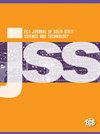Comparative Study of Chemical Activation and Physical Activation Approach to Optimize Biomass-Based Doped Carbons for Energy Applications
IF 1.8
4区 材料科学
Q3 MATERIALS SCIENCE, MULTIDISCIPLINARY
ECS Journal of Solid State Science and Technology
Pub Date : 2024-05-20
DOI:10.1149/2162-8777/ad4de1
引用次数: 0
Abstract
Two approaches have been utilized to optimize the energy storage characteristics of doped carbon materials derived from Lignosol, a biomass product, to address the rising energy demand issues. Herein, phosphorus and nitrogen co-doped carbon (PNDC) materials with varying doping agent volumes were synthesized by utilizing microwave irradiation. Chemical activation and physical activation were employed to enhance these materials’ characteristics. Chemical activation was performed in a one-pot, single-step process, rather than a traditional multi-step protocol, using small amounts of potassium hydroxide. Furthermore, the physical activation method required multiple steps: doped carbon was prepared via microwave, exposed to water, filtered, frozen and then dried. With this, the expansion properties of water at freezing temperatures were exploited to alter the materials’ surface characteristics. All materials were characterized and compared for their physicochemical properties. All defect ratios supported the presence of doping. Additional results revealed that both chemical and physical activation approaches effectively modify the topographical features as well as the electrochemical activity (charge storage) of the doped carbon materials. The chemically activated doped carbon exhibited the highest resulting surface area of 1352 m2/g and a specific capacitance value of 347 F g-1 with excellent cycling stability as compared to other similarly synthesized materials.比较研究化学活化和物理活化方法,优化能源应用中的生物质掺杂碳
为解决日益增长的能源需求问题,人们采用了两种方法来优化从生物质产品木质素(Lignosol)中提取的掺杂碳材料的储能特性。在这里,利用微波辐照合成了不同掺杂剂量的磷氮共掺杂碳(PNDC)材料。化学活化和物理活化被用来增强这些材料的特性。化学活化是通过使用少量氢氧化钾的单锅、单步工艺进行的,而不是传统的多步工艺。此外,物理活化法需要多个步骤:通过微波制备掺杂碳、将其暴露在水中、过滤、冷冻,然后干燥。这样就利用了水在冰冻温度下的膨胀特性来改变材料的表面特性。对所有材料的物理化学特性进行了表征和比较。所有缺陷率都证明了掺杂的存在。其他结果表明,化学和物理活化方法都能有效改变掺杂碳材料的形貌特征和电化学活性(电荷存储)。与其他类似的合成材料相比,化学活化掺杂碳的表面积最高,达到 1352 m2/g,比电容值为 347 F g-1,并且具有出色的循环稳定性。
本文章由计算机程序翻译,如有差异,请以英文原文为准。
求助全文
约1分钟内获得全文
求助全文
来源期刊

ECS Journal of Solid State Science and Technology
MATERIALS SCIENCE, MULTIDISCIPLINARY-PHYSICS, APPLIED
CiteScore
4.50
自引率
13.60%
发文量
455
期刊介绍:
The ECS Journal of Solid State Science and Technology (JSS) was launched in 2012, and publishes outstanding research covering fundamental and applied areas of solid state science and technology, including experimental and theoretical aspects of the chemistry and physics of materials and devices.
JSS has five topical interest areas:
carbon nanostructures and devices
dielectric science and materials
electronic materials and processing
electronic and photonic devices and systems
luminescence and display materials, devices and processing.
文献相关原料
| 公司名称 | 产品信息 | 采购帮参考价格 |
|---|
 求助内容:
求助内容: 应助结果提醒方式:
应助结果提醒方式:


